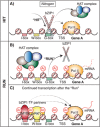"Hit-and-Run" leaves its mark: catalyst transcription factors and chromatin modification
- PMID: 26108710
- PMCID: PMC4548861
- DOI: 10.1002/bies.201400205
"Hit-and-Run" leaves its mark: catalyst transcription factors and chromatin modification
Abstract
Understanding how transcription factor (TF) binding is related to gene regulation is a moving target. We recently uncovered genome-wide evidence for a "Hit-and-Run" model of transcription. In this model, a master TF "hits" a target promoter to initiate a rapid response to a signal. As the "hit" is transient, the model invokes recruitment of partner TFs to sustain transcription over time. Following the "run", the master TF "hits" other targets to propagate the response genome-wide. As such, a TF may act as a "catalyst" to mount a broad and acute response in cells that first sense the signal, while the recruited TF partners promote long-term adaptive behavior in the whole organism. This "Hit-and-Run" model likely has broad relevance, as TF perturbation studies across eukaryotes show small overlaps between TF-regulated and TF-bound genes, implicating transient TF-target binding. Here, we explore this "Hit-and-Run" model to suggest molecular mechanisms and its biological relevance.
Keywords: TF binding; dynamic regulation; gene regulatory networks; transcriptional model; transcriptional regulation; “Hit-and-Run”.
© 2015 The Authors. Bioessays published by WILEY Periodicals, Inc.
Figures


References
Publication types
MeSH terms
Substances
Grants and funding
LinkOut - more resources
Full Text Sources
Other Literature Sources
Research Materials
Miscellaneous

